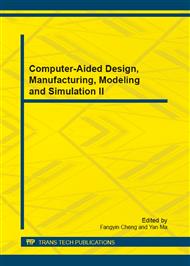p.1111
p.1117
p.1121
p.1125
p.1130
p.1135
p.1140
p.1144
p.1149
Test Unit Design of Magnetorheological Greases Conductivity Research Based on Labview
Abstract:
This paper described the characteristics of open virtual equipment platform LabVIEW, and introduced the method to construct data collecting system using this platform. And developed computer controlled monitoring unit of magneto-rheological grease conductivity, tested the relation between magneto-rheological grease conductivity and external magnetic field, particle concentration, and thickness of magneto-rheological grease. In windows system, the virtual instrument constructed by using LabVIEW programming implemented the real time measurement, display, record of conductivity output, analysis its conductivity characteristics, and fitted the output electric resistance data and determined the best fitting curve. The experiment certified that this method doesn't need complex programming, reduces the programming time, and simplifies the development procedure, and increases the flexibility of detection system.
Info:
Periodical:
Pages:
1130-1134
Citation:
Online since:
December 2012
Authors:
Price:
Сopyright:
© 2013 Trans Tech Publications Ltd. All Rights Reserved
Share:
Citation:


